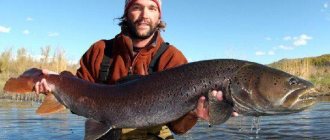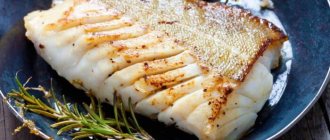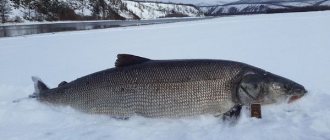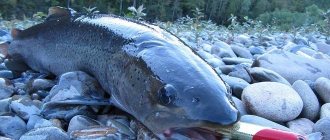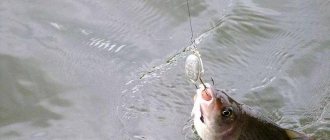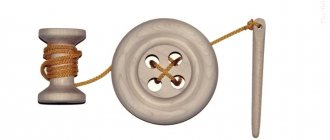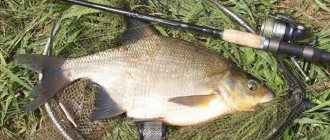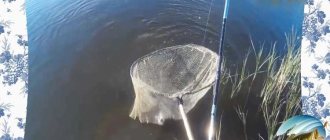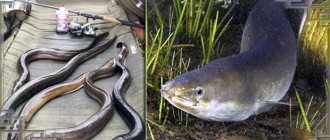Description
Siberian taimen is a predatory species of the Salmon family. Reaches truly gigantic size and weight. An adult can be 1.5–2 meters long and weigh 50–70 kg. This fish lives exclusively in freshwater mountain and lowland rivers and glacial lakes. Never goes to sea.
Interesting! Despite the fact that taimen, like all salmonids, loves cold water, it is not found in the Arctic - the rivers of this region have a very poor food supply and are unable to feed such a predator.
Nutrition and lifestyle
Taimen is an active shadowhunter. On sunless or rainy days, he switches to round-the-clock nutrition, and his diet:
- other fish (burbot, char, sculpin, tugun, perch, grayling);
- amphibians (frogs, newts);
- small mammals (mice, rats, squirrels, muskrats);
- waterfowl (mallards, pintails, geese, bean gooses, lesser white-fronted lesser white-fronted geese).
Many cases of attacks by large predators on dogs and foxes crossing the river have been recorded. In the warm season, the share of non-fish food in the menu can be 35-40%. Because of such gluttony and indiscriminate eating, the taimen was nicknamed the river tiger.
Young Talmen feed on chironomid and honeydew larvae, worms, leeches, crustaceans, and fry. At 3-4 years, a gradual abandonment of zooplankton and benthos occurs in favor of representatives of ichthyofauna. As fish grow, the potential of their jaw, swallowing and digestive systems increases dramatically. The young predator is capable of hunting prey no larger than 15-17% of its own body length. In adults, this figure is an impressive 40-42%.
Taimen is a single fish, less often a pair fish. Spends late spring and summer in cold tributaries with a constant supply of spring or melt mountain water. From mid-autumn, it goes on vacation to the main channels of large lowland rivers, which by this time have time to cool down from the summer heat.
To learn more:
Burbot: what kind of fish is this?
Where to fish
In the river, taimen prefers to stay in places with a calm current. The most promising areas for catching it are: areas above rapids and rifts;
- local holes and pits located downstream from rifts or rapids;
- places behind large boulders and trees lying in the water;
- areas located at the entrance to and exit from a narrowing river channel;
- wide reaches with a slow current and a depth of up to 2–2.5 meters;
- pebble and rocky spits bordering deep holes;
- the mouths of small streams and small rivulets flowing into the main river.
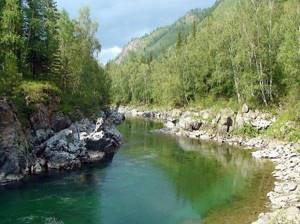
The reach of a mountain river is a promising place for catching taimen
At night, this predator often hunts in shallow waters with a flat bottom and a slight current. In lakes, taimen prefers to stay in deep holes and pools, the mouths of rivers and streams, places where there are cold springs at the bottom and there is an influx of fresh water.
Tunguska Night fishing
The Tunguska River is full-flowing and the current in it is quite fast. The bottom is rocky with rifts, where large schools of fish live. The river freezes a meter deep in winter, so winter fishing here presents certain difficulties. The best way to get to the places is by boat, leaving the Yenisei River in the Tunguska, which is a tributary and replenishes its waters. You can also fly by helicopter when organizing a fishing tour.
As soon as the name of the river is remembered, questions about the Tunguska meteorite immediately arise, but fishing is in a completely different place. Tunguska is the Gloomy River, which became famous in the film based on Shishkov’s novel.
Victoria Leshchenko
I've been working hard in the fishing tackle department for the past six years. I can help you assemble almost any gear.
Ask a Question
The places here are semi-wild, there are very few populated areas and there is a chance that you will be alone for a hundred kilometers. Guides accompany you to the places where the meteorite fell, and in this area you can see and photograph a lot of interesting things.
The places in the north are very far from civilization and, living in their small villages, people eat mainly fish and prey from hunting. In ancient times there were large state farms producing furs here. Gloomy - the river was navigable in the old days. A lot of cargo was rafted and transported along it, and now along the shore you can see dilapidated buildings and rusty barges. There are lonely hunting huts on the banks, where you can, if necessary, wait out the night and go fishing.
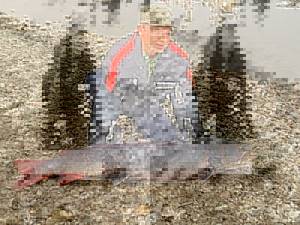
Fishing at night has the disadvantage of the presence of many types of mosquitoes - blood-sucking ones. When going fishing in these parts, it would be good to stock up on a net or mosquito repellent. If you fish in the middle of the river, on a boat, there are almost no mosquitoes. The river itself at its source is very capricious and seething. But in its middle part it turns into a wide expanse, where splashes of large fish are visible. The river bottom is rocky, there are holes where large schools can hide. Taimen are well caught using a heavy spinner and a mouse. Night fishing turns into trophy fishing. At night you can catch very large taimen, the only pity is that you need to release this fish back into the river.
Fishing time
During the entire open water season, taimen experience three peaks of activity:
- Post-spawning – this peak of taimen activity occurs in early and mid-June. At this time, the spawned predator gradually slides downstream to summer camps - reaches, holes, areas below rapids and rifts. To replenish the nutrients lost during spawning, the predator begins to actively feed. This peak ends with the onset of summer heat in early and mid-July.
- Autumn - at the end of summer and beginning of autumn, as the water temperature gradually decreases, the predator begins to actively hunt in order to stock up on nutrients for the long and harsh winter. This peak of activity continues until the freeze-up.
Before spawning, which occurs in early and mid-May, the predator that rises to the upper reaches of rivers practically does not react to any artificial or natural bait. During the day in summer, the predator is most active in the early morning (from dawn until 9 o’clock) and late evening (after 5–5 p.m.) 18 hours). In autumn, when the water has cooled sufficiently, the fish are active throughout the daylight hours.
Tackle for taimen
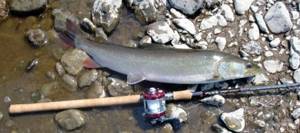
The most popular tackle for catching taimen is a spinning rod. At the same time, a fairly powerful rod is used, since a fairly large specimen can bite, although smaller taimen resist quite strongly. To do this, take a two-handed rod, about 3.5 meters long, or even more.
The thickness of the fishing line is chosen to be at least 0.7 mm. If you take a thinner line, then a break is guaranteed at the first bite. Unlike pike, taimen are not able to bite through the fishing line, so it makes no sense to use leashes. Particular attention should be paid to the choice of hooks, because this fish has a powerful jaw. A powerful fishing rod must be equipped with an equally reliable and powerful reel. At least one hundred meters of fishing line should be wound on the reel so that you can starve it out. A pre-adjusted friction brake can be equally important. It will help dampen the powerful jerks of strong fish.
Tackle
The most interesting and rewarding way to catch taimen is with a spinning rod. The large size and weight of the caught specimens, as well as the very stubborn resistance of the predator when fishing, dictate the need to use durable and reliable gear, consisting of the following components:
- 3.5-meter powerful two-handed plug rod with fast action and bait weight from 10 to 40–60 grams;
- a multiplier or powerful inertia-free reel of size 3000–4000 with a gear ratio of no more than 1:3;
- main monofilament nylon line with a thickness of 0.4–0.6 mm or a braided cord with a cross-section of 0.2–0.3 mm.
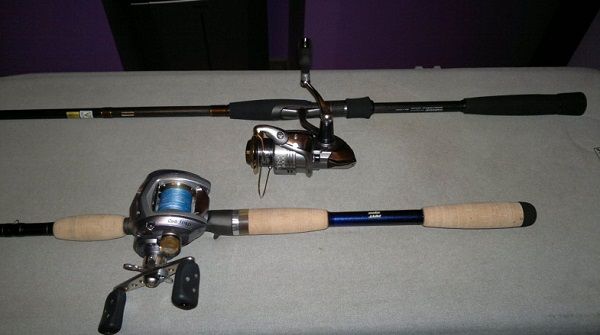
Spinning rods for catching taimen
Fishing for taimen
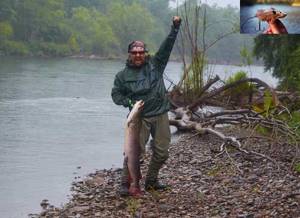
Fishing for taimen is possible in consultation with local authorities and only after obtaining official permission and a license to catch it. At the same time, the fisherman, after catching taimen, can take a photo with it as a souvenir, and then must release it back to its native element. You can only take wounded individuals that are unlikely to survive in the wild. There are no restrictions on the time of year when catching taimen. The only exception is the spawning period, during which fishing for this predator is prohibited by law.
Mostly taimen are caught using spinning rods and fly fishing. At the same time, large artificial baits are attached to the fishing line, which can attract a giant. The best bait for fishing a predator is considered to be an artificial mouse, the movement of which along the surface of the reservoir will not go unnoticed by the taimen, who love to feast on the defenseless rodent swimming across the river.
Lures
Taimen can be caught using the following spinning artificial baits:
- Large and medium spinners Blue Fox Supervibrax, Kuusamo Haukilippa.
- Heavy vibrators Kuusamo Rasanen and Professor.
- 120mm minnow-class wobblers from Rapala and Yo-Zuri.
- Artificial mice and chipmunks (squirrels) are quite realistic floating baits, equipped with two sharp, large and durable treble hooks. Unlike spinners and wobblers, such imitations of rodents are used for fishing for large trophy taimen.
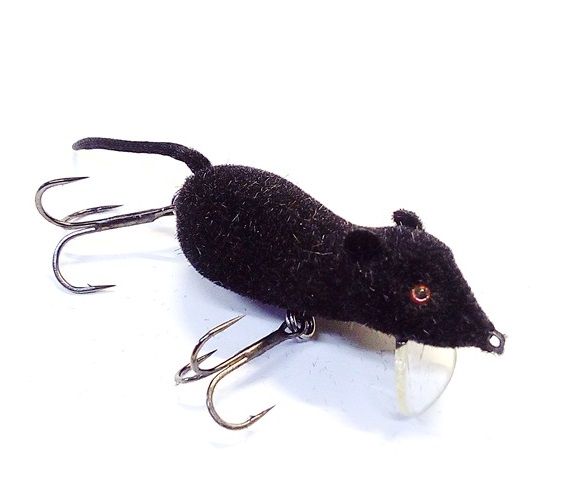
Artificial bait - “Mouse”
Since taimen is an endangered species, it can only be caught with a special permit (license). The spinning angler can photograph the caught fish, measure it, and then must release it into the reservoir. It is permissible to keep taimen if, when catching and landing, the fish was severely damaged, preventing it from subsequently surviving. Fishing without a permit, as well as failure to comply with the catch-and-release principle, can lead to serious consequences - from a hefty fine to a criminal case.
The implementation of licenses and control over the catch of taimen are carried out by the territorial divisions of the Federal Fisheries Agency.
Geographical habitats
There are two concepts - habitat and biotope. The habitat is the area where representatives of this genus or species can live. A biotope is the same type of biogenic and abiogenic environmental conditions in which a set of species included in a given biocenosis lives.
The range is limited to the Asian part of Russia. These fish are found in the rivers of the Urals, Yakutia, the southern part of the Far East, Khakassia, Buryatia, and Transbaikalia.
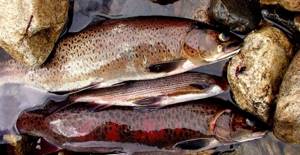
If we describe the area by water bodies, it includes the following rivers:
- Pechora;
- Kama;
- Aldan;
- Amur;
- Tugur;
- Yana;
- Tunguska;
- Zeya;
- Gilyuy;
- Anyui;
- Choir;
- Abakan;
- Katun;
- Yenisei;
- Angara;
- White;
- Vitim;
- Barguzin;
- Avvakumovka.
Taimen can also be found in lakes Teletskoye and Khanka.
It is found only in clean, transparent taiga rivers and lakes. Despite its similarity in appearance to pike, it also has habits like catfish. Both of them love to live where there are many pools and holes. Such a large body needs to be hidden in holes, and deep ones. After resting in shelters, taimen go hunting.
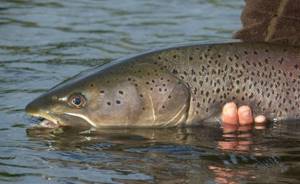
The weight of an adult reaches 60-80 kg
When to catch
Immediately after spawning you can start catching this fish. The fishing season continues until ice appears on the rivers. If it is possible to fish even in winter, then taimen are no exception and will be hooked even in the depths of winter. It is most active after spawning and before the onset of winter, when it needs to stock up on nutrients. Somewhere from the beginning of September until serious cold snaps, taimen actively bite, both during the day and in pitch darkness. The most productive periods are the time intervals from 8 o'clock to 10 o'clock in the morning, as well as from 17 to 20 o'clock in the evening, although it bites outside these time intervals, but not so actively. Taimen, like other fish, is seriously affected by weather conditions. To be precise, there are changes in temperature and pressure, so taimen can shift their activity either by day or by night. Therefore, you must always be prepared for the fact that taimen will stop taking bait altogether, regardless of its type.
